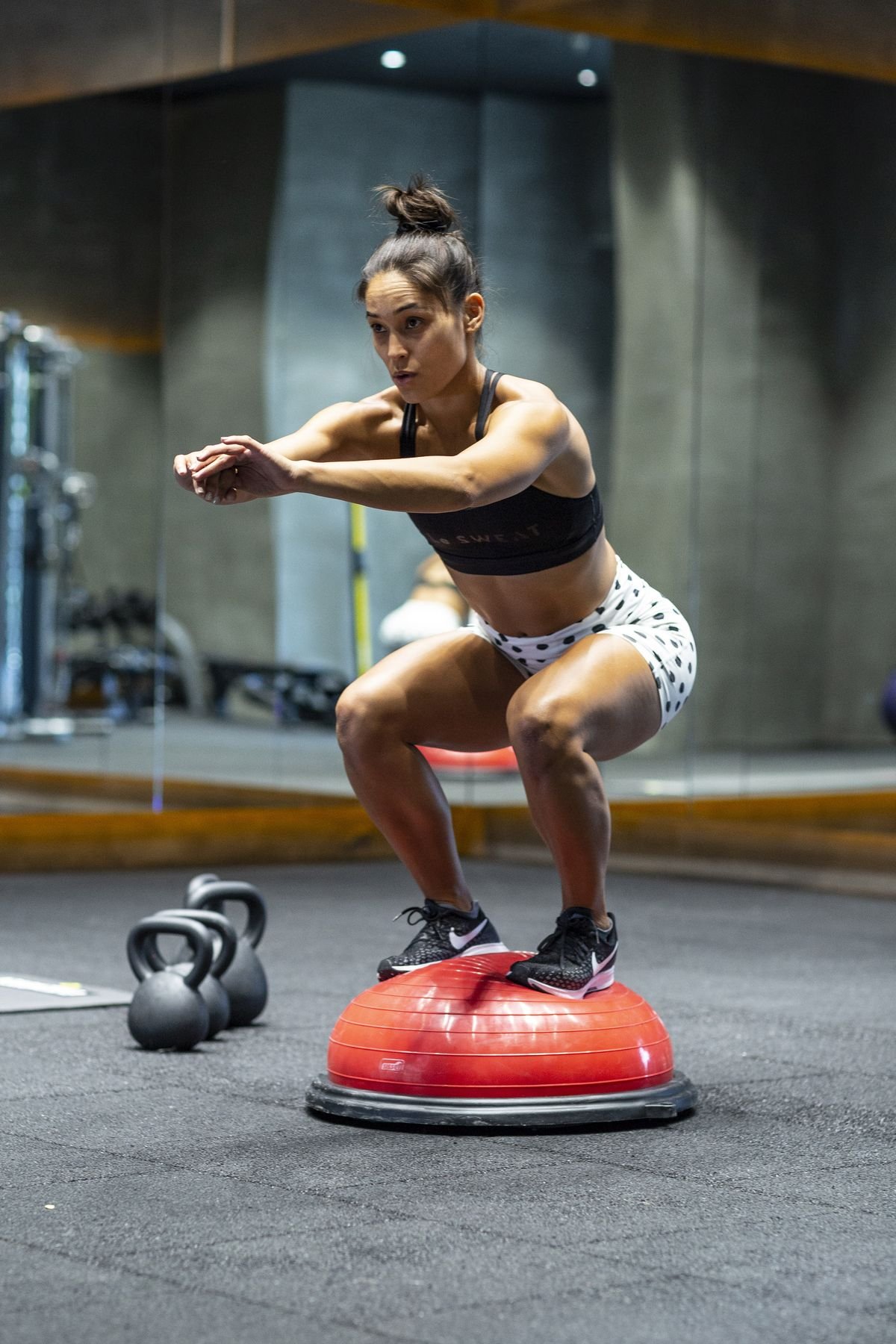Instability training
The ability to change direction with and without the ball and carry at speed are game-based tasks that may benefit from the incorporation of instability training modalities into your program. They have the potential to positively influence directional change and agility making use as they do of resistance training on unstable surfaces like Swiss and Bosu balls. Targeted plyometrics and neuromuscular training interventions are also combined with unstable surfaces workouts to improve the directional change capability of team-sport athletes, with most evidence accrued to date coming from professional football. Lessons can be applied to the peculiarities of field hockey movements with decent transposition of training content.
Some evidence
There are conflicting schools of thought when it comes to the relevance and efficacy of resistance training on unstable surfaces (RTUS) for improving field sport athlete strength and power. I admit to some skepticism before stumbling onto a comprehensive, well balanced research review, Behm & Colado (2012) athough it was intended for physical therapy interventions in the main. The researchers maintain that their investigation of the body of evidence highlighted the confirmatory bias of much of the work that maligned the comparatively poorer force, power and velocity improvements accruing from RTUS vs traditional resistance training modalities. RTUS does generate relatively greater trunk muscle activation pointing to a greater stabilizing function for the muscles and a thorough segue to training adaptations for coordination tasks.
It is indisputable that the evidence demonstrates significant force reductions when performing force or power actions under unstable versus stable conditions. However, improvements in balance and proprioception (awareness of body position - crucial in movement tasks in field hockey) from resistance based balance training has been shown to improve functional performance measures such as strength, power, agility, running, and other activities. The review by Behm & Colado found that balance training alone with no strength, power, or functional training on average improved measures of functional performance by 31%. Furthermore, increased core muscle activation when performing some exercises under moderately unstable versus stable conditions has been shown when performing chest press, push‐ups, and squats.
It may be that some degree of RT with unstable surface equipment such as Bosu balls can play a role in improving stabilizer muscles and activating the core so it is worth considering as a potential modality for field hockey STAC. As to which particular exercises, dose variables and periodised placement you should consider, it is best to consult your sports science specialist and they will only advise you after a thorough assessment.
How you can go about it
Here, at VOITTO we would tend to marry BOSU workouts with plyometrics and neuromuscular routines designed to enhance balance and agility across the entirety of a periodised plan. This is particularly important in mid to later-aged masters players because the neuromuscular stimuli underpinning dynamic agility workouts makes a measurable difference to mental health and acuity as well as attenuating falls risk; Morat et.al, (2020). So, what exactly do we mean when we talk about a player’s change of direction (CoD)? It characterizes an athletes’ ability to decelerate in the shortest possible time and to re-accelerate quickly in a new direction. CoD represents the physical quality of agility while perceptual and decision-making factors constitute the underlying cognitive components of agility. It’s our belief that integrative neuromuscular training incorporating fundamental and specific movements through dynamic stability, balance, core strength, plyometric and agility exercises may improve movement biomechanics. The work of Morat et.al, and others bears this out.
To train agility, various unilateral rotation movements are practiced, initially unloaded but eventually loaded with a scalable level of resistance. Typically, reaction time drills with varying cues, in situ rotational movements in free then passively contested space after warm up would kikc a session off. Plyometrics would start in the first 2 micro-cycles as resistance-free and some exercises such as side to side ankle hops, standing long jumps, one-legged lateral jumps, lateral jumps over a hurdle, double leg hops, cone hops with 180° side-cuts would provide a foundation. By the 3rd micro-cycle lightly weighted plyo routines would appear. The final piece of the puzzle is RTUS involving dynamic stability, core strength and balance exercises. Again, without resistance then progressing.
It’s important to include agility training and ensure your periodised plan is tailored to your age, relative mobility, injury history, cardiovascular fitness and take into consideration any pre-conditions that may impinge on coordination tasks done under physical duress. It is an oft overlooked part of preparation for hockey at all level and at all ages.
Curated workout content
We do not recommend or endorse any third parties other than Approved Voitto Associates (AVA). This following list of links to workout videos is by no means definitive not does it constitute professional advice on our part none of the providers is a member of AVA.
Bosu
Simple warm up
Intro rotational
References
Behm, David, and Juan Carlos Colado. 2012. “The Effectiveness of Resistance Training Using Unstable Surfaces and Devices for Rehabilitation.” International Journal of Sports Physical Therapy 7 (2): 226–41.
Morat, Mareike, Oliver Faude, Henner Hanssen, Sebastian Ludyga, Jonas Zacher, Angi Eibl, Kirsten Albracht, and Lars Donath. 2020. “Agility Training to Integratively Promote Neuromuscular, Cognitive, Cardiovascular and Psychosocial Function in Healthy Older Adults: A Study Protocol of a One-Year Randomized-Controlled Trial.” International Journal of Environmental Research and Public Health 17 (6). https://doi.org/10.3390/ijerph17061853.
Zouhal, Hassane, Abderraouf B. Abderrahman, Gregory Dupont, Pablo Truptin, Régis Le Bris, Erwan Le Postec, Zouita Sghaeir, Matt Brughelli, Urs Granacher, and Benoit Bideau. 2019. “Effects of Neuromuscular Training on Agility Performance in Elite Soccer Players.” Frontiers in Physiology 10 (July): 947.


